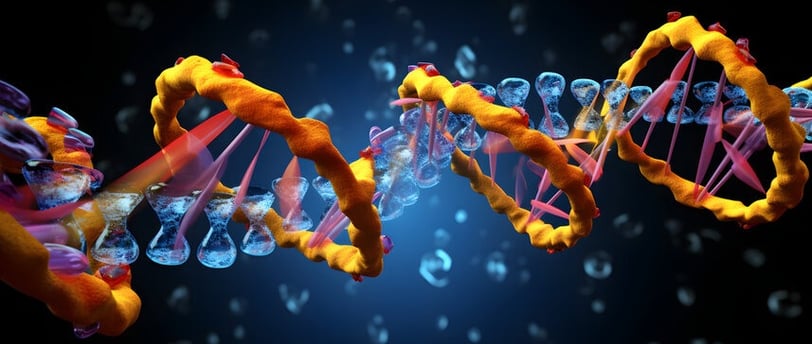The Endocrine Disrupting Chemicals Crisis
# EDC Crisis: Root Causes and Solutions ### By Russ Maher RN BSc (Hons), Founder of BeingWELL.Me This exploration identifies Endocrine Disrupting Chemicals (EDCs) as the primary driver of disease affecting all life forms today. Evidence demonstrates EDCs' role in the surge of autoimmune conditions, thyroid disorders in young women, premature cardiac issues in men, and neurodivergent conditions like autism (increased from 1:150 in 2000 to 1:36 today) and ADHD (rising 4% annually). Corporate interests have systematically undermined public health protections, profiting from both producing harmful chemicals and treating resulting conditions. In response, BeingWELL.Me presents a solution-focused framework centered on: 1. Mitochondrial cellular health optimization 2. Soil remineralization initiatives 3. Community-based water purification This approach emphasizes individual empowerment through teaching by example and community collaboration. Rather than waiting for regulatory intervention, we must recognize that "no one is coming to save us—we must empower ourselves through choosing to collaborate with each other." This paradigm shift transforms our relationship with health by acknowledging the interconnection between human wellbeing, soil vitality, and clean water. **Keywords:** EDCs, autoimmunity, mitochondrial health, soil restoration, neurodivergency
STEM CELLSDIETINFLAMMATION
Russ Maher RN BSc (Hons)
5/5/20257 min read


The Silent Epidemic: How Endocrine Disrupting Chemicals Are Fueling the Global Health Crisis
Introduction
We find ourselves at a critical juncture in human history, facing an unprecedented health crisis that affects not only our species but all life on Earth. At the center of this crisis lies a class of substances known as Endocrine Disrupting Chemicals (EDCs) – pervasive compounds that interfere with hormone function and have become virtually inescapable in modern life. Despite mounting scientific evidence linking these chemicals to numerous serious health conditions, they continue to proliferate in our environment. This article examines why we are in this precarious position and the forces that maintain the status quo despite the alarming evidence.
What Are Endocrine Disrupting Chemicals?
Endocrine disruptors are natural or man-made chemicals that may mimic or interfere with the body's hormones, known as the endocrine system. These chemicals are linked with many health problems in both wildlife and people. Our endocrine system, a complex network of glands and hormones, regulates virtually every aspect of our physiology, from metabolism and growth to reproduction and immune function. EDCs disrupt this delicate system by mimicking, blocking, or altering hormone activity, often at extremely low doses.
Endocrine disrupting chemicals are found in many everyday products, including some cosmetics, food and beverage packaging, toys, carpet, and pesticides. Some chemicals that act as flame retardants may also be endocrine disruptors. Contact with these chemicals may occur through air, diet, skin, and water. According to the National Institute of Environmental Health Sciences, even low doses of these chemicals can have significant health impacts because hormones naturally operate at very small concentrations.
The Health Impact: More Than Just a Theory
The impact of EDCs on human health is both profound and far-reaching. "A well-established body of scientific research indicates that endocrine-disrupting chemicals that are part of our daily lives are making us more susceptible to reproductive disorders, cancer, diabetes, obesity, heart disease, and other serious health conditions," as noted in a report from the Endocrine Society and International Pollutants Elimination Network (IPEN).
Evidence continues to mount that EDCs are key contributors to the rise of autoimmune diseases. Research from the National Institutes of Health shows that autoimmunity appears to be rising in the U.S., with adolescents experiencing the sharpest increase. These conditions occur when the immune system attacks healthy cells instead of protecting the body against disease.
Multiple lines of evidence suggest that autoimmunity and autoimmune diseases are on the rise, with current projections indicating they will become even more prominent disorders in the future. The rapid increase in these conditions suggests environmental factors, rather than genetic changes, are likely driving this trend.
EDCs and Specific Health Concerns
Autoimmune Disease Epidemic
The connection between EDCs and autoimmune disorders is particularly concerning. Research has demonstrated that EDCs such as Bisphenol A (BPA), a chemical compound widely used in plastics and resins, can affect human immune function and promote the occurrence and development of autoimmune diseases. When the immune system becomes dysregulated due to EDC exposure, it can begin attacking the body's own tissues, leading to conditions like rheumatoid arthritis, lupus, multiple sclerosis, and Hashimoto's thyroiditis.
Thyroid Disorders in Young Women
Thyroid disorders have shown alarming increases, especially among young women. Many studies have evaluated the effect of environmental or occupational endocrine disruptors on the thyroid gland, finding they can lead to thyroid autoimmunity. These disorders can manifest as either hypothyroidism (underactive thyroid) or hyperthyroidism (overactive thyroid), both of which can have profound effects on metabolism, energy, mood, and overall health.
Despite their ubiquitous distribution and disastrous effects on human endocrine health, endocrine disruptors form a poorly explored class of environmental toxins with respect to public awareness and scientific studies. This lack of awareness compounds the problem, as many people remain uninformed about the risks these chemicals pose.
Cardiovascular Issues in Younger Men
The impact of EDCs extends to the cardiovascular system as well. Both thyroid hormone excess and deficiency can induce or exacerbate cardiovascular disorders, including atrial and ventricular arrhythmias, atherosclerotic vascular disease, dyslipidemia, and heart failure, thereby contributing to higher risk of premature morbidity and death. These effects can manifest in younger populations now more than ever before.
Hyperthyroidism directly affects the cardiovascular system, altering the heart's normal function and leading to high cardiovascular mortality. Excess thyroid hormones are associated with significantly increased risk and prevalence of cardiac arrhythmias, particularly atrial fibrillation (AF). These cardiac manifestations can be particularly troubling in younger men who would otherwise not be at high risk for heart issues.
Neurodevelopmental Issues and the Dramatic Rise in Neurodivergence
One of the most alarming trends in public health today is the dramatic increase in neurodevelopmental conditions. The prevalence of autism spectrum disorder has risen from approximately 1 in 150 children in 2000 to 1 in 36 today according to recent CDC data. Similarly, diagnoses of ADHD have increased by about 4% annually in recent years. These statistics represent millions of families navigating complex neurological conditions that affect learning, behavior, and social interaction.
EDCs have been strongly implicated in this surge of neurodevelopmental disorders. These chemicals can disrupt the delicate hormonal balance critical for proper brain development, particularly during prenatal and early childhood periods when the brain is most vulnerable to environmental influences. A California study evaluated whether maternal pregnancy exposure to agricultural pesticide compounds affects offspring's risk for cerebral palsy (CP). The study reported maternal first trimester exposures to 15 pesticides suspected to affect the estrogen, and 7 pesticides suspected to affect the thyroid hormone system, were associated with a modest increase in risk for CP in the female offspring.
What's particularly troubling is how this public health crisis has spawned a massive industry profiting from the management—rather than prevention—of these conditions. The "autism industry" alone represents billions in annual revenue across pharmaceuticals, specialized therapies, educational tools, and institutional services. Many of the same corporations producing or using EDCs in their products also manufacture medications and therapies for the very conditions potentially caused by these chemicals. This creates a perverse profit incentive where companies benefit financially from both creating environmental toxins and treating their effects.
Why Are We Not Addressing the Problem?
Given the overwhelming evidence of harm, one must ask why we continue to allow these chemicals to proliferate in our environment. Several factors contribute to this disturbing reality:
Corporate Influence and Profit Motives
Research has documented tactics used by industries to avoid regulation, including front groups, lobbies, promises of self-regulation, lawsuits, and industry-funded research that confuses the evidence and keeps the public in doubt. When industries are involved in policy-making, the most effective control measures are often downplayed or omitted entirely.
Corporations generally would be considered as single issue lobbies. If a corporation wishes to change public policy, or to influence legislation which impacts its success as a business, it may use lobbying as a "primary avenue" for this purpose. The chemical industry, pharmaceutical companies, and other manufacturers of EDC-containing products have powerful lobbying arms that work to prevent or water down regulations.
Regulatory Limitations
Current regulatory frameworks are ill-equipped to address the complex nature of EDCs. According to researchers, several issues make the study of endocrine disruptors challenging, including different levels and time of exposure and different action across different ages as well as gender. Traditional toxicology follows the principle that "the dose makes the poison," but EDCs can have significant health impacts at extremely low doses, a paradigm that current regulatory structures struggle to incorporate.
Information Asymmetry and Public Awareness
Despite the seriousness of the threat, public awareness of EDCs remains limited. Endocrine disruptors form a poorly explored class of environmental toxins with respect to public awareness and scientific studies. Without public pressure for change, the political will to enact meaningful restrictions on these chemicals remains weak.
The Path Forward: A Solution-Focused Approach
Addressing the EDC crisis requires action on multiple fronts, but perhaps most importantly, it requires a fundamental shift in how we approach our own health and well-being. At BeingWELL.Me, I advocate for a solution-focused approach that begins with optimizing mitochondrial cellular health. When our cells function optimally, our bodies have greater capacity to detoxify and repair damage from environmental exposures.
The path forward includes:
Focus on Cellular Health: Supporting mitochondrial function through proper nutrition, targeted supplementation, and minimizing toxic exposures creates resilience against EDC impacts.
Soil Remineralization and Microbiome Restoration: The health of our soil directly impacts human health. Depleted soils produce nutrient-deficient foods that compromise our immune systems. We must prioritize initiatives that restore soil microbiomes through regenerative agriculture, community gardens, and farming practices that avoid EDC-laden pesticides while replenishing mineral content. By supporting those who have already begun this work, we can follow their example and accelerate positive change.
Water Purification and Collection Systems: Clean water is fundamental to health. We must invest in household and community-scale water filtration systems that effectively remove EDCs, while also developing rainwater collection infrastructure that reduces dependence on contaminated water sources. Many pioneering communities have already implemented such systems—their successes provide valuable blueprints we can follow.
Independent Research: More independent, publicly funded research is needed to fully understand the health impacts of EDCs and to counter industry-funded studies that may downplay risks. This research must integrate wisdom from both conventional and traditional knowledge systems.
Green Chemistry: Investment in developing safer alternatives to EDCs can help transition away from harmful chemicals without economic disruption. Many innovators are already creating safer alternatives—we must amplify and support their work.
Empowered Self: Healing: No one can heal you except yourself. While healthcare practitioners can guide and support, each individual must take responsibility for their own healing journey.
Teaching By Example: There are only three ways we can teach—by example, by example, and by example. We must embody the changes we wish to see, focusing first on our own health and well-being.
Community Collaboration: No one is coming to save us. We must empower ourselves through choosing to collaborate with each other. Know your land, know your water, know your communities, and know your relationships—are you in the right relationships?












